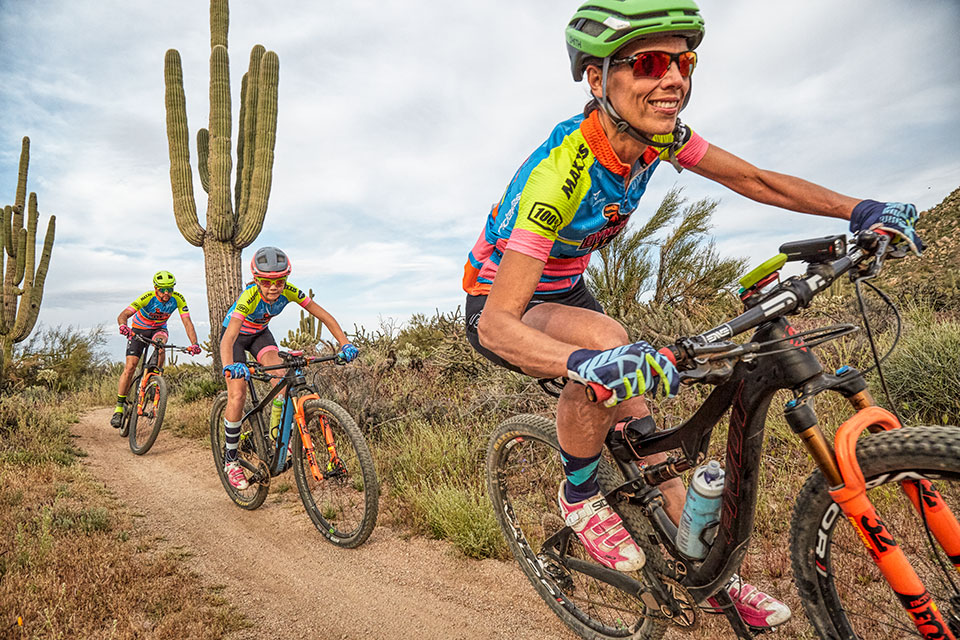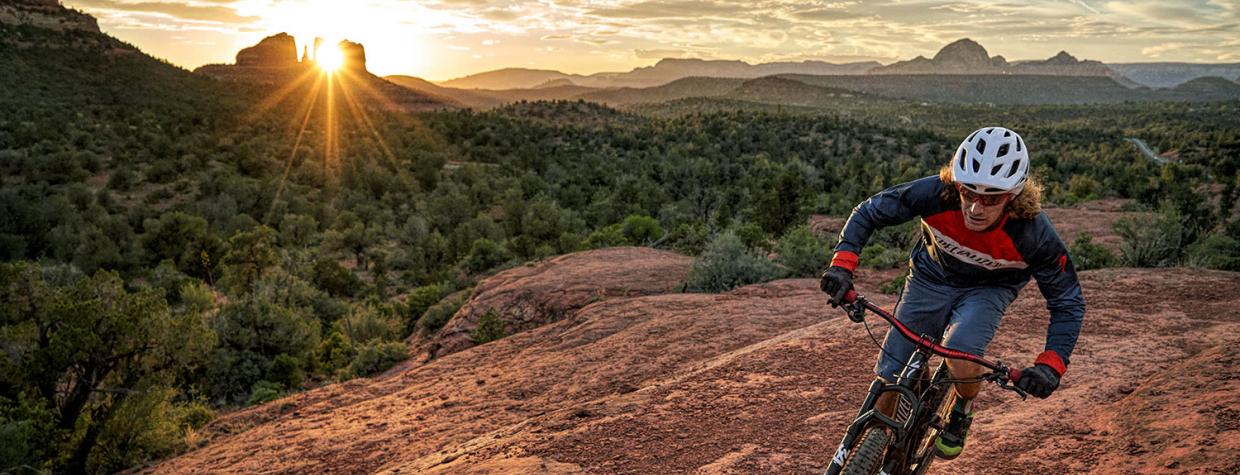This story starts with falling off a mountain bike, onto wet red clay, in front of a lot of people.
Riders from the Verde Valley Cyclists Coalition have offered to take me out on the first of two rides I’ll take in Sedona. We depart from Absolute Bikes and approach the Bell Rock Pathway, a popular trail just up the street from the shop. These riders — Martin Glinsky, Marlene Macek, Pam Milavec and Mike Harris — each hold leadership roles at the VVCC, a nonprofit, volunteer-run group that promotes mountain biking in the region and responsible ridership. Its members also volunteer as patrol on the trails.
I’m brand new to mountain biking, and I’ve never before met a dropper seatpost — which allows a rider to raise and lower the seat with a lever on the handlebars, much like how an office chair operates. It’s no surprise, then, that when I brake to stop, I forget to lower the post and take a tumble sideways because my feet can’t reach the ground.
My risk aversion and lack of coordination aren’t the only reasons this is only my second time on a mountain bike. The sport has an unusually high barrier to entry: It requires an initial outlay of money, a prohibitive amount of equipment and the stamina to keep up, making it intimidating to all but the most confident athletes.
Before I signed up for this ride, I feared I’d end up on a trail too advanced, huffing and puffing at the back of the pack while everyone else rode effortlessly and had to wait for me at the top. But I wanted to try mountain biking in Arizona, and if I was going to do it anywhere, it was going to be in the mountain-bike mecca of Sedona, steeped in Red Rock Country’s cycling culture and community. I’d been warned, though: Sedona isn’t for beginners.
Across town at Over the Edge Bikes, it smells like tires — the sharp, rubber, just-out-of-the-box punch on the inhale. It’s all cement floors, hand tools hanging from pegboards, jerseys on display and the constant tsk-tsk-tsk of thin metal spokes spinning. A couple of 20- or 30-somethings work at the front register, and a few more tinker with bikes in the back. Mike Raney, the owner of the shop, knows everyone who walks in — by the time they leave, anyway.
It’s not mountain biking’s high season or even the prime time of day for riding, but this place still hums with energy. An older gentleman, a self-proclaimed Deadhead, won’t stop blathering about the last concert he attended. Two regulars who went riding a few hours ago return and crack open a beer on the back patio, where they discuss the ride. They do this after every ride. It’s indicative of the scrappy, communal cycling culture here, and elsewhere in Arizona. These riders are enamored by the human-powered nature of bikes, the series of levers and gears that work hard only if the operator does.
Raney walks me to the back of the shop, where a big table is set up to study maps of Sedona’s labyrinth of trails. He unfolds a single-track map marked with the same symbol system as a ski resort — blue squares, black diamonds, double black diamonds. Sedona’s “beginner” trails are graded on a curve — bunny hills don’t exist here, but there are a few you can start on if you’re willing to point your skis and go.
The Sedona Mountain Bike Academy, founded in January 2019, operates out of Over the Edge. Amaryth “Amo” Gass and Evan Puglia created the academy to make the sport more approachable. Puglia says the majority of their business is newbies but adds that even pros can benefit from going to bike school.
Gass is one of the academy’s few female instructors, so she often is matched up with female clients. She takes me on my second ride of this trip, in Long Canyon, a few minutes from Sedona’s main drag. Before we depart, she explains how a rider’s center of gravity moves on the bike, and presents a few guidelines: The two main positions are “neutral” and “ready”; brake evenly between the front and the back; and pick a sight line, because if you look at the cactus in front of you, you’ll fall into it.

The ride is a gradual climb — not enough to feel the elevation, but certainly enough to get my heart rate up. The terrain as we cut onto the Deadman’s Pass Trail is rocky, and the clay smells heavy with fresh rain. At the top, just a few miles in, we’re far from everything, set against a backdrop of hoodoos and pines. Although much of Arizona lends itself to picturesque riding, this is the stuff of National Geographic.
With a wide grip, I brace against the handlebars, squat off the seat and plant my feet on the pedals at 3 and 9 while navigating around rocks, ledges and roots. The nubby tires flick and slap dirt onto the backs of my legs. I trust my body to maneuver the handlebars and my brain to make the technical calculations and respond to feedback, as momentum pushes me downhill faster than I can think about the movements.
We roll back into the trailhead sweaty, accomplished and having burned enough calories to eat whatever we want for dinner.
Arizona’s trail system is different from those anywhere else in the U.S., and enthusiasts and tourists, many of them seeking an alternative to hiking, come from all over the world to ride here year-round. That’s part of the reason Raney founded the Sedona Mountain Bike Festival, held every March at the city’s Posse Grounds Park. Five thousand people, from serious athletes to people who’ve never been on a mountain bike, come for a weekend of bike demonstrations, trail rides, concerts and a beer garden full of like-minded cyclists.
Even though I’m here for just a short time, I can see the depth of Sedona’s mountain biking culture. Glinsky says it’s because the area’s cyclists share a respect for the trails and the outdoors. As a collective, they seem to have their eye on the future, working to build and maintain the trails they frequent.
“Most places generate money from recreation permit use or wood cutting or some other natural resource, but our trails are our resource,” says James Godwin, who works for the U.S. Forest Service and also picks up shifts at Over the Edge. Every day, these cyclists watch the way the sun bounces off the rusty rocks at sunset, and they want to make sure every person who visits can do the same.
But the mountain biking community is bound not only by values; it’s also bound by the outdoors as gospel. Acting as missionaries, they’re trying to articulate how much love they have for the mountain, the bike and the intersection of the two — tripping over their own words, trying to convince others to try it, trying to convert.
This isn’t unique to Sedona’s mountain biking culture and community. My first time on a mountain bike was at Scottsdale’s McDowell Sonoran Preserve, where I experienced the same affection toward the sport. Amy Regan, my guide, knew everyone out on the trail.
Through that experience, I met Tim Racette and Dominick Marino, two avid cyclists who live in the Phoenix area. They glow when they talk about the sport and how, because of Arizona’s climate, they can ride every day of the year. Marino says the “excitement per kilojoule” is high with mountain biking.
When I ask riders about favorite trails in Sedona, I get similar answers over and over again: Hiline, Mescal, High on the Hog. But Raney has a more obscure choice: He likes Ridgeway, because it’s awkward. “You’re in a constant stress state,” he says. “It’s a series of split-second decisions.”
For those who ride, the sport creeps into every part of their lives. They work at the bike shop. They’re friends with other cyclists. They go out to ride most weekdays after work. Every weekend, their bikes visit the technical terrain. Some have retired here in Sedona and wake up every day asking themselves where they’ll ride that day. Some do volunteer patrol or advocacy. Others work four jobs, trying to make ends meet, just to live in a place that has beautiful views and hundreds of trails within riding distance.
I ask Cam Rose, a mechanic at Absolute Bikes, why he keeps coming back to mountain biking. He doesn’t hesitate: “I don’t keep coming back to it. I just never leave it.”
How to Explore Arizona on a Bike
Start at the local bike shop.
Your local shop can rent you equipment, relay information about trail access and point you in the right direction, no matter if you’ve never ridden a bike, are a pro or fall somewhere in between.
Join a free ride.
Bike shops all over the state host free rides open to anyone who wants to join.
Go with a friend.
Make the barrier to entry less cumbersome by getting on the trail with a local. Mountain bikers are dying to share their passion, and they might even have a bike you can borrow.
Pack enough water and snacks. Take more water than you think you’ll need. And you certainly don’t want to be without snacks.
Head to the trail with a guide.
If you’re not from the area or are new to the sport, hire a guide for a few hours. On-trail, hands-on learning tailored to you can be what makes or breaks whether you’ll want to go mountain biking again.
Leave your ego at the trailhead.
You might fall off the bike. You might be the last one to the top. You’ll see the same view when you get there.

